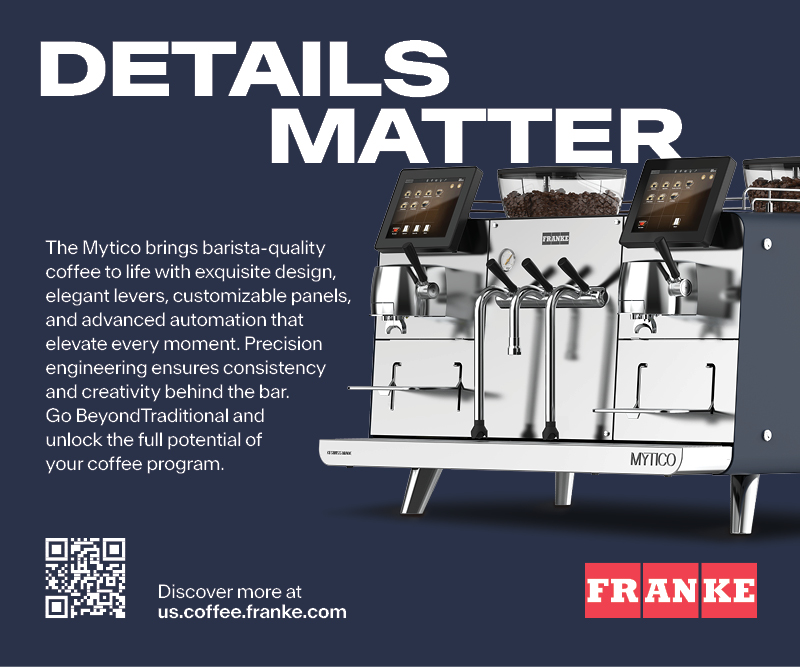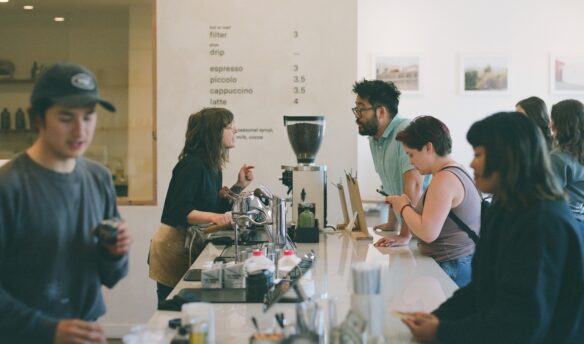This story appears in The Coffee Shop Handbook, Fresh Cup’s print resource for coffee shop leaders—get your copy here.
Success looks different for every coffee shop. For some founders, success means having a specific amount of money in the bank. For others, it’s being able to gainfully employ a set number of staff members. And for some, it can be measured by the number of new locations the business opens as it grows.
It’s all too easy to become overwhelmed trying to track every business metric under the sun, from sales figures and calculations to projections and reports. But you don’t have to pay attention to every single metric, especially when only a select few have any bearing on your goals.
However, while everyone’s version of “success” is different, there are universal metrics business owners can use to measure the progress and health of their coffee shops. From unpacking revenue and understanding COGS to determining break-even points and measuring employee retention, we spoke with business owners and cafe consultants about which metrics matter most for coffee shops.
Sales and Expenses
Let’s start with the basics: sales and expenses. Sales means money in, and expenses means money out. But if that seems too simple, that’s because it is.
If you look solely at how much money is coming in and how much is leaving the business, you won’t have a full understanding of why and how each transaction is happening. Instead, there are various metrics within each category that can help you determine how effective your business is at generating sales and managing costs.
Revenue
Of course, one of the major metrics a coffee shop needs to track is revenue—the money generated from business operations. Tracking and setting revenue benchmarks is key for any company. But that’s only the beginning. Owners should also use revenue tracking to discover trends, opportunities, and weaknesses within their businesses.
Revenue Classification
Revenue classification, or revenue classes, refers to the categories of sales that drive income. For a coffee shop, these can include, but aren’t limited to:
- Espresso-based beverages
- Tea products
- Baked goods
- Whole-bean coffee
- Merchandise and retail items
- Wholesale transactions
- Sandwiches and salads
Revenue classes reveal which products and services are driving the greatest (or least!) amount of revenue, and how each category is trending. For instance, if you notice that your baked goods sales are down by 20% month-to-month, this should signal that something is off or not working.
Revenue Trends by Time Period
If you’ve ever worked as a barista (which we highly recommend for anyone planning to open a coffee shop), you probably know that January tends to be the slowest month of the year. Customers are burned out from holiday shopping and travel, and spending as a whole is down.
Revenue trends can fluctuate by season, month, day of the week, and even hour. But you’ll only know this if you break down your sales reports.
For example, if you notice that Tuesdays are your slowest day of the week, you can take steps to either increase sales on that particular day or decrease costs by scheduling labor accordingly.
Grit Coffee is located in Charlottesville, Virginia, which is a college town. Due to the town’s yearly fluctuations in population, one of the coffee shop’s core revenue metrics is year-over-year (YOY) sales, which it then uses to plan its labor schedule, menu, and more accordingly. In a previous conversation with Fresh Cup Magazine, Dan FitzHenry, co-owner and general operations manager at Grit Coffee, explained, “We’ll look at YOY sales and the transition periods where students are going out of town or back into town.”
Revenue KPIs
There are many ways to analyze coffee shop revenue. Daily sales, specific monetary benchmarks, breakdowns by sales channel—the list can go on seemingly forever.
But fixating on every single revenue metric will drive most coffee shop owners mad. Erica Escalante, a cafe and bakery consultant with more than 15 years of industry experience, notes that it’s beneficial for business owners to analyze granular revenue metrics, such as hourly sales, in the beginning of operations. But as the years go on, it’s not as important to hone in on every tiny datapoint.
“As you get more mature in your business, you can start stepping back and stop paying attention to these little metrics where you analyze numbers all day,” she says. “And instead, you can do this once per month and eventually once per quarter. The goal is to understand the fluctuations at the beginning, have your big benchmarks, and work toward strategizing for the big goals.”
Instead, pick three or four revenue metrics that mean the most to your business and focus solely on those.
Karen Bassett, co-founder and CEO of Wayfarer Coffee Roasters in Laconia, New Hampshire, explains that identifying a few key benchmarks can actually open your eyes to the revenue-generating opportunities right in front of you. “Our director of operations has benchmarks to hit weekly and monthly,” she says. “So, he knows how many hours he can give for payroll. He knows what our average sales are. He knows what [goals] we’re trying to hit. As a cafe or coffee company owner, the key is finding that balance between saving money and generating revenue.”
In analyzing those benchmarks, the team at Wayfarer Coffee Roasters realized that if they opened on Sundays—a business practice they had not traditionally followed—they could generate significantly more revenue each year. “That became our second-busiest day of the week and added hundreds of thousands of dollars in revenue per year,” Bassett says.
Escalante recommends assigning “average ticket size” as one of your revenue metrics. “Average ticket size is how I monitor the health of sales,” says Escalante. “When I’m thinking about increasing sales, I’m watching that metric and analyzing how much customers are spending per visit.”
Cost of Goods Sold (COGS)
Unfortunately, the adage that “you have to spend money to make money” is 100% true—especially for coffee shops, which rely on numerous ingredients and components to craft drinks, food menus, and customer experiences.
Cost of goods sold, or COGS, is a metric used to calculate the direct costs of producing the goods sold by your company.
In a coffee shop, these costs include, but aren’t limited to:
- Materials (cups, lids, sleeves)
- Ingredients (whole-bean coffee, milk, syrups)
- Labor
- Overhead (rent, utilities, etc.)
The higher your costs, the lower your margins (and vice versa).
Let’s use the cost of producing a 12oz latte* as an example:
- Coffee: $0.15
- Milk: $0.30
- Cup: $0.05
- Lid: $0.05
- Sleeve: $0.10
- Labor: $0.40
- Overhead: $0.40
Total Cost: $1.45
*Your actual costs will vary.
Knowing these costs, if you sell your 12oz latte for $2.50, you’re only making $1.05 in revenue. Depending on your business model, this 42% margin may or may not be enough to cover all costs.
Calculating and monitoring your coffee shop’s COGS is not only a great way to ensure that ingredient, inventory, and labor costs remain manageable, but also to determine if your products are priced appropriately.
Our director of operations has benchmarks to hit weekly and monthly. So, he knows how many hours he can give for payroll. He knows what our average sales are. He knows what [goals] we’re trying to hit. As a cafe or coffee company owner, the key is finding that balance between saving money and generating revenue. karen Bassett, wayfarer coffee roasters
Dr. Kenneth Thomas, owner of Umble Coffee in Starkville, Mississippi, explains that he closely monitors his business’s COGS as a way to determine pricing. “Let’s say your cost of goods sold [for a cup of coffee] are arbitrarily $2 and you’re selling it for $3,” he says. “That’s likely not high enough of a margin after factoring in all of your other costs to run the business. So, you can do one of the following things: leave it and find a way to increase volume, take it off the menu, or increase pricing.”
Escalante echoes Thomas’ sentiment, adding that a coffee shop’s cost of goods sold should ideally be below 30% of its total budget. “With COGS overall, it’s about understanding and controlling your costs and pricing out your menu accordingly. The number one mistake I see coffee shop owners make is not pricing out their menu properly. Pricing out your menu is the number one way to make more money.”
Gross Profit and Net Profit
One common mistake first-time coffee shop owners make is confusing gross profit and net profit.
Gross profit is used to determine how much money is left over after a sale by subtracting COGS from revenue. Net profit is the money left over after all business expenses have been deducted.
The most important point to understand is that having a gross profit does not mean your business will generate a total (net) profit. Other business expenses—such as debt/loan payments, taxes, marketing costs, and software subscriptions—can detract from your coffee shop’s ability to turn a net profit.
Break-Even Point
Opening and operating a coffee shop is a costly endeavor. You need to make your money back on all expenses. But unless you calculate the break-even point, you won’t know how many cups of coffee or bags of beans you’ll need to sell to reach that goalpost.
Calculate the break-even point of your coffee shop (or a particular expense) by using the following formula:
Break-even point = Fixed costs / Gross profit per product
Fixed costs are costs that remain the same month-to-month. These can include rent, utilities, insurance, contracted services such as pest control, salaried labor, and more.
Since not every product will have the same gross profit margin, you can calculate the break-even point using an average gross profit margin. This will give you a general idea of how many cups of coffee, sandwiches, or whole-bean coffee bags you need to sell to hit the break-even point on your initial investment.
Customer Acquisition Cost
Between fabricating signage, executing a social media strategy, printing flyers, and networking within the local community, driving customers to a new coffee shop isn’t cheap. And that makes it all the more important to calculate your customer acquisition cost, using the following formula:
Customer acquisition cost = Total amount spent on sales and marketing efforts / # of new customers that visited your coffee shop
Understanding customer acquisition cost helps coffee shop owners make wise decisions in relation to their marketing efforts. If the price to pay a social media agency is $2,000 per month, yet it only generates 40 new customers in that time frame, you’re paying $50 for each new customer. Unless these customers are spending more than $50 per order, the price you’re paying for the agency may not be a wise investment for your business.
On the other hand, a partnership with another local business that costs $100 but yields 100 new customers may be well worth the initial investment.
Labor Costs
Labor is an essential part of running a coffee shop. You need baristas to prepare and serve drinks, cashiers to handle transactions, and kitchen or bakery staff to produce delicious food items. Depending on your business model, these roles may be handled by three separate employees, or shared by one or two staff members who handle multiple responsibilities.
In analyzing benchmarks, the team at Wayfarer Coffee Roasters realized that if they opened on Sundays—a business practice they had not traditionally followed—they could generate significantly more revenue each year. “That became our second-busiest day of the week and added hundreds of thousands of dollars in revenue per year,” says Bassett.
While employee roles and responsibilities are a topic for another day, what’s important is that coffee shop owners properly manage their labor costs. Ideally, labor expenses should be approximately 20–30% of your expenditures for a given time period. As Escalante points out, these ranges can fluctuate based on factors like the breakdown of hourly and salaried employees or the structure of your business and barflow. For example, a local cafe operated by a general manager may have a higher labor percentage than a regional chain drive-thru business with multiple hourly employees.
To calculate labor costs, use the following formula:
Labor cost percentage = (Labor Costs / Total Revenue) x 100
For Escalante, it’s important to keep in mind that if your labor cost percentage is higher than average (35–40+%), those extra costs are coming from another part of your budget, such as your COGS or marketing spend. “When a part of your budget is bigger, it’s not necessarily bad! But, you’re going to have to take away from something else. All aspects of your budget affect each other,” she says.
Certain time periods at your business may be slower or busier than others, and your staffing levels can affect that day’s overall profitability. Dr. Thomas not only looks at his total labor cost percentage for a given time period, but also at the hourly labor percentage of his coffee shop. “In a perfect world, I would like to keep it at 25 to 35%,” he says. “You know, some days we hit that and some days, we don’t. For example, looking at our numbers in real time, right now we’re at 28.34% for today.”
Employee Retention Rate
One error Escalante frequently sees new coffee shop owners make is hiring employees without truly understanding how to lead, or without having a leadership position in the cafe. This can lead to issues with employee retention.
To calculate employee retention, use the following formula:
Employee retention rate = (# of employees at the end of a set time period / # of employees at the start of a set time period) x 100
Naturally, retaining employees can be a challenge for a multitude of reasons. To make this process easier, she recommends first taking the time to understand and solidify your coffee shop’s mission and value system before hiring. “Everything you do in your coffee shop sends a message to somebody. Most people don’t know what their brand is or explore it, and then they start adding people to the mix and it causes a lot of confusion, disruption, and fires.”
Qualitative Metrics
Many coffee shop owners like concrete data. Knowing exactly how many blueberry scones typically sell in a week, or the fluctuations in milk pricing throughout the year, is helpful in running an effective and profitable business. But some metrics are not quantifiable, and are still just as important to monitor for the long-term success of your business.
Customer Satisfaction
Yelp and Google have review systems with star ratings, but these only tell business owners (and customers) a fraction of the story. Moreover, sales and customer satisfaction aren’t always directly correlated. So how can you determine how customers really feel about your coffee shop, products, and level of service?
Average ticket size is how I monitor the health of sales. When I’m thinking about increasing sales, I’m watching that metric and analyzing how much customers are spending per visit. Erica Escalante, cafe and bakery consultant
Bassett recommends not paying too much attention to online reviews and instead focusing on building relationships with your customers. “I’ve seen many, many business owners obsess about the one negative review out of the 500 amazing reviews they’ve got,” she says. “That’s not where your energy needs to be, that’s not fixing anything. Focus instead on creating a positive customer experience and an excellent-quality product.”
The easiest way to gauge customer satisfaction at your coffee shop? Ask!
Quality of Life
We’re not going to sugarcoat it: Opening and operating a coffee shop requires a lot of work. As the owner, it’s your responsibility to make sure everything functions properly. Sometimes it feels like the chaos of fixing problem after problem will never end. Escalante refers to this as “being a firefighter.”
“If you feel like you are constantly putting out fires all the time and there isn’t a break, that’s not a healthy metric,” she says. “There are seasons in business where two people put in their notice at the same time, another is having a baby, and it’s chaos. But if there’s not an endpoint to that season, then that is a metric that something is going wrong—either in leadership, or operational leadership, like you don’t have good policies in place, and you’re not being a good leader.”
Escalante notes that when a coffee shop owner experiences a lower quality of life or lack of balance, that’s often connected to their interpersonal relationships and leadership skills. “When I see business owners who are in year three and it’s still nonstop, [I tell them] there is a way to get out of that.”
As you endure the journey of opening and operating a coffee shop, keep an eye on how many times you have to assume the role of firefighter. If it becomes your full-time job, leaving you with little time to focus on metrics like profitability or customer satisfaction, it’s time for something within your business to change—such as staffing, role responsibilities, and various internal systems.
Let’s say your cost of goods sold [for a cup of coffee] are arbitrarily $2 and you’re selling it for $3. That’s likely not high enough of a margin after factoring in all of your other costs to run the business. So, you can do one of the following things: leave it and find a way to increase volume, take it off the menu, or increase pricing. Dr. Kenneth Thomas, Umble Coffee
As your business grows and develops documented processes and a dedicated team, you’ll begin to feel your quality of life balance back out again. Bassett explains that after several years in the coffee business, she and her team had to discuss what success meant for them. “You have to start with the question, ‘What is success?’ Is it solely financial? For my family, success means we don’t have to clock in for shifts. That’s something we value as a family.”
Getting to that point takes time, well-organized systems, and a team you can rely on. Bassett notes that while Wayfarer Coffee Roasters isn’t a big company with numerous full-time employees, those who are in full-time positions take on larger responsibilities to keep the company running smoothly—leaving Bassett to enjoy more time with her family.
At the end of the day, the purpose of analyzing various metrics is to ensure that your business is on track to reach its defined goals. For some, this is a financial target. For others, it’s a quality-of-life goal. As Escalante reminds us, “You have to focus on yourself and your goals. Make that plan and stick to your budget!”














